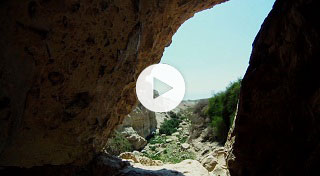47:1–12 Ezekiel’s temple tour concludes at the entrance of the temple proper, where he finds a stream of water coming from beneath the temple and flowing east. Ezekiel’s guide walks him through the water, measuring the growing river and testing the depth until it becomes impassable just over a mile from the temple. The water flowing from the temple gives life and renews the land it flows through. If this holy district and sacred city represents Jerusalem, the life-giving power of the river would be significant in restoring the region east of Jerusalem—a dry, lifeless wilderness approaching the salty waters of the Dead Sea. Ezekiel seems to envision a river of life that heals the waters of the Dead Sea and turns the wilderness into a lush orchard. This imagery recalls the book of Isaiah, where the deserts bloom under Yahweh’s redemptive hand (see Isa 35:1). |
47:3 a measuring line The man had both the measuring reed and a line or cord (see Ezek 40:3). He used only the reed in the temple measurements.
a thousand cubits Many English translations follow the Hebrew text and give the distance in cubits; others convert the cubits to feet. Assuming that Ezekiel is using the long cubit (1.75 feet), 1,000 cubits is 1,750 feet, and the total distance covered through v. 5 is more than 1.3 miles.
ankle deep At each 1,000 cubit mark, they test the water’s depth. The depth increases exponentially.
47:8 the Jordan Valley Refers to the rift valley of the Jordan River, including the Sea of Galilee and the Dead Sea.
of the Jordan River, including the Sea of Galilee and the Dead Sea.
to the sea The Hebrew text refers to the Dead Sea simply as “the sea.”
simply as “the sea.”
into the sea where they issue out, and the waters The high concentration of salt in the Dead Sea prevents all life. This incoming river will restore the water’s ability to sustain plant and animal life.
47:10 from En Gedi and on up to En Eglaim Locations on the shore of the Dead Sea. Engedi is on the western shore near the midpoint of the sea. The location of Eneglaim
is on the western shore near the midpoint of the sea. The location of Eneglaim is unknown.
is unknown.
the great sea The Hebrew text refers to the Mediterranean Sea as the “great sea.”
as the “great sea.”
47:13–23 Ezekiel outlines the boundaries of the land allotted to Israel in detail. The assignment resembles the boundary lists from Num 34 and Josh 13–19. |
47:14 an inheritance Refers to traditions about Israel’s inheritance of the land. See note on Ezek 36:12.
47:15 Hethlon This location is uncertain. It likely was on the coast of the Mediterranean in modern Lebanon, north of Tripoli.
is uncertain. It likely was on the coast of the Mediterranean in modern Lebanon, north of Tripoli.
to Zedad A village in northeastern Syria.
in northeastern Syria.
47:16 Berothath A city in Syria. See 2 Sam 8:8.
in Syria. See 2 Sam 8:8.
Sibraim This location is unknown. The text places it between Damascus and Hamath, perhaps on the eastern border of Syria.
between the boundary of Damascus and the boundary of Hamath A prominent city in southern Syria.
in southern Syria.
Hazer Hatticon A village in northeast Syria.
the boundary of Hauran The region south of Damascus and east of the Sea of Galilee.
47:17 Hazar Enan A village in northeast Syria.
47:19 Meribot Kadesh Also known as Kadesh-Barnea, an area in the northeast Sinai desert.
an area in the northeast Sinai desert.
the wadi A dry riverbed in the northeast Sinai desert. It forms a natural boundary between the Negev desert of Israel and the Sinai of Egypt.
47:20 Lebo-Hamath See Ezek 47:15. The complete perimeter of the border was described.

|
About Faithlife Study BibleFaithlife Study Bible (FSB) is your guide to the ancient world of the Old and New Testaments, with study notes and articles that draw from a wide range of academic research. FSB helps you learn how to think about interpretation methods and issues so that you can gain a deeper understanding of the text. |
| Copyright |
Copyright 2012 Logos Bible Software. |
| Support Info | fsb |
 Loading…
Loading…
 Arabah
Arabah 

